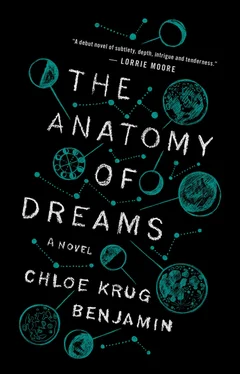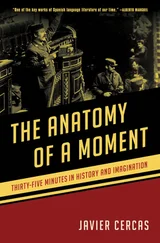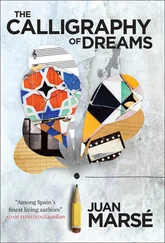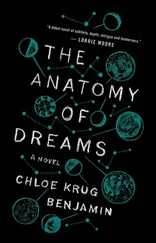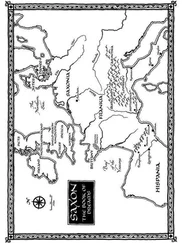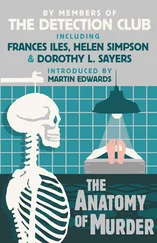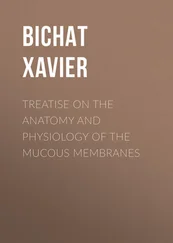Gabe and I walked back to the dorms without speaking. There was a bright ball of fury in my chest, and I knew it would burst if I opened my mouth. But it was something deeper than anger that made me quicken my pace until Gabe, scrambling behind me, gave up and hung back. I felt betrayed. We had chosen each other: we had lain in my top bunk twined in conversation, our secrets loosening through the night like slipknots. He knew me as well as Hannah—maybe better. But he had lied to me about where he went at night, and for no reason better than his own pathological need to stick his nose where it didn’t belong. His dogged interest in Mr. Keller’s garden was so peculiar that it made me feel humiliated—for believing that he was different from other boys, for believing that he had grown up.
Classes resumed the next day, and I avoided him. When I did see him—sitting across the room in physics or walking to the dining hall, lagging behind his friends and trying uncertainly to catch my eye—my stomach vaulted, and I looked away. I spent most of my free time with Hannah in the workshop, a high-ceilinged warehouse at the edge of campus. During the day, it housed art classes, but in off-hours it was available to students. In our first year at Mills, Hannah and I signed up for Introduction to Painting. We thought it would be a steal: two periods a week to mess around with color, periods when we wouldn’t have to use our minds. But it was the hardest class I took. Physics required logic, but the logic of painting was different—one that came from a place below the neck rather than above it and required hours of experimentation.
“I want you to mix a color,” Ms. Mildanovich had said, winding her way through our tables. “A color only you know.” I chose the dusty gray-blue of my old baby blanket. And though I could picture this color exactly in my mind, everything I mixed looked wrong and too potent on paper. The blanket was airy, diffuse, a tone I could better describe by feel than color. It was twilight, soft and shadowed; it had volume, like sheep’s wool. Later that semester, I found an old sponge beside the workshop sink and layered paint until I got it right. That was when I realized that colors had shapes as well as tones. To find them, I had to use touch as much as sight, invention as much as memory.
Now I abandoned the painting of objects—the curved bowls and closed hands, the hard little apples—and studied Nocturne in Black and Gold , a crinkled page in the “Abstract” section of our art textbook: its smear of fire and light, its luminous darkness. The appeal of abstraction was psychological, too, for I could paint a piece whose true subject only I knew. I could hide things there: the angles Gabe’s body took in bed, or the way I felt when I woke from my dreams of him. Sitting on the pale floors of the workshop, I did more than tell those stories: I encrypted them. Beneath layers of oil, in a box within a box, were shapes only I could read.
Now that I knew what Gabe had been doing with his nights—or at least where he’d been going—the idea of him was tainted for me. There seemed to be something shameful about him, something sordid with which I had unwittingly become involved. He’d plucked me out from inside the person I’d always thought I was and made me question my own judgment. But I cared too much to let go of him. I was insatiably curious, hysterical with late-blooming girlhood. What was he doing? Was there someone else with him? I pictured him clasped in the woods with Diana Gonzalez, the curviest girl in our senior class, or exploring the garden with Nina; once, I dreamed of her pearl-gray eyes, iridescent as nail polish, her bare body pressed to his.
In a strange way, I felt I had a responsibility to protect him. Nobody else knew where he went at night, and after Keller’s warning, I wanted to make sure he didn’t sacrifice his tenuous parole. I woke each morning around five, when the mountains were barely outlined in light, and sat at the window. For three nights, I didn’t see him. But on Thursday, at five thirty, he came around from the back of the house and walked swiftly toward the dorms. There had to be a pattern, I thought, and I was right: he was gone over the weekend, but he was back on Tuesday and Thursday. This schedule continued for two weeks, during which the dreams I’d been having, and their strangely correlating physical injuries, were absent—which made me even more convinced that something about my relationship with Gabe had inspired them.
December brought no snow: in Humboldt County, winter was cool and wet. At forty-five degrees, you could get away with a sweater, though the moisture in the air would cling to it as it did to the soft, bright bark of the redwood trees. Among us students, there was an atmosphere of feverishness. We had gotten a taste of vacation over Thanksgiving, and December was a mad dash to winter break, hurdled with final exams. During our history exam—rain splashing the windows, the furious scratch of thirty pencils on paper—Gabe was absent. I rushed through my essay on Spanish colonization and slapped it on Ms. Callaghan’s desk, Hannah staring at me in wonder. Then I stopped by the dorm for my raincoat and set out in search of him.
I found him in the attic of the library. He was leaning against one of its octagonal walls with a physics textbook in his hands.
“So you ditched our history final, and now you’re studying for physics,” I said. “Waste of time. At the rate you’re going, I doubt you’ll even make it to the end of the semester.”
Gabe looked up. His knees were tucked in toward his chest, and notebooks were spread out around him. Faint light shone through the tower’s windows, and his eyes looked bare and squinty, as they did in the morning.
“What do you mean?”
“I’ve seen you,” I said. “Tuesdays and Thursdays, like clockwork. You’re lucky if Keller hasn’t spotted you again, but he will. The thing I can’t understand is why you keep doing it.”
Gabe put the physics book down and straightened his legs.
“It wasn’t me,” he said.
“Please, Gabe.”
“It wasn’t.” He raised his eyebrows. “How can you be sure? It’s dark out at that time of morning. Have you ever seen my face?”
“You sound pretty defensive for someone who supposedly wasn’t there.”
“Hardly.” Gabe’s features relaxed, as if on command.
“Oh, come on,” I said. “Who else could it be?”
“David Horikawa. Michael Fritz. It was Mike who told me about Keller’s flowers, you know—those ones with the doubled disks. He’s been convinced for months Keller’s running experiments in that garden. I’m not the only one curious about it.”
“You expect me to believe there’s a whole band of kids running around Keller’s place at night?”
“All I’m saying is it wasn’t me.”
“But I know you,” I said. It was the only thing I could hold on to, the only thing that convinced me I wasn’t delusional. “I know the shape of your body, what it looks like when you walk.”
I was almost crying. After the months we’d spent together, this cool confrontation was excruciating. I knelt down in front of him, putting my palm on his knee.
“Gabe,” I said.
But he only looked out the window, putting his hand over his eyes like a visor. When he turned toward me again, his face had the same blank look I’d seen that night at Keller’s.
“I’m sorry,” he said. “I have to work.”
He picked up the physics book again. When he opened it and began to read, underlining every so often, it was as if I wasn’t even there.
• • •
That evening, I collapsed in my bunk. Hannah was out, and being alone made me cry even harder; I blew my nose so loudly that someone in the room next door banged on the wall and shouted, “ Je- sus Christ, cut it out with the foghorn!” I fell asleep in my clothes, my eyes swollen shut. When the door opened, I thought it was Hannah, coming back from the common room at lights-out. But when someone climbed up to my bunk, the wooden ladder creaking more than it ever did beneath Hannah’s ninety-five pounds, I realized it had to be Gabe.
Читать дальше
